 |
|

|
 |
TABLE of CONTENTS
 |
MnROAD celebrates 20th anniversary, prepares for next research phase |
By Shannon Fiecke, Research Services & Library

MnROAD worker Bob Strommen demonstrates an Automated Laser Profile System, which is used for measuring rutting and cracking in asphalt pavements, to MnDOT student workers (from left) Justice Harvieux, Mike Quach and Joe Casanova at the Aug. 6 MnROAD open house. Photo by Shannon Fiecke |
Researchers from around the world rely on MnROAD, Minnesota’s pavement testing center. Minnesota alone saves at least $33 million each year, thanks to quantifiable advances made at MnROAD. The annual nation-wide savings is even larger: $749 million.
At an Aug. 6 open house, this one-of-a-kind research facility celebrated 20 years of finding ways to make roads last longer, perform better and cost less.
MnROAD partners with the Federal Highway Administration and dozens of other states and countries to conduct research on two live test tracks in rural Albertville.
No other cold-weather facility offers such an array of pavement types with thousands of electronic sensors recording both environmental changes and dynamic truck testing.
“If not for MnROAD, many of our projects wouldn’t be nearly as successful,” said Larry Wiser, Federal Highway Administration highway research engineer.
MnROAD consists of two separate road segments located next to Interstate 94 near Albertville. The road segments contain 51 test cells, with different combinations of surface materials, aggregate bases and subgrades, as well as variations in structural design and drainage features.
MnROAD’s initial research on pavement life and performance (from 1994 to 2006) reduced maintenance costs, repairs and motorist delay.
In the second phase of research, MnROAD reconstructed almost 40 test cells for more than 20 different studies. The benefits derived from this work are estimated to be worth nearly nine times what the studies cost – and that’s just the benefit for Minnesota.
“We’re excited for the third phase of research, which will be mainly focused on maintenance and rehabilitation,” said Ben Worel, MnROAD operations engineer. “We’ve seen the benefits of our past research and expect the same in the future.”
For more information about MnROAD, check out the website or watch a video about a MnDOT employee whose job is to drive a semi-tractor trailer around a closed-loop test track at the facility.
MnROAD’s facility includes:
– A test section of I-94 carrying live traffic
– A low-volume roadway that simulates rural road conditions
– Thousands of sensors that record load response and environmental data
|
|
 |
|

|
 |
TABLE of CONTENTS
 |
Minnesota takes, passes ‘zero deaths’ challenge on I-90, I-94 |
By Kristin Kammueller
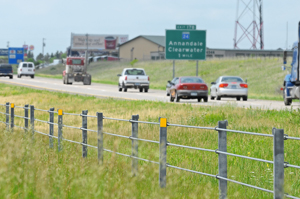
No fatal crashes occurred Aug. 1-4 on Interstate 94 during an effort with a goal of zero deaths. The Minnesota State Patrol initiated the I-90/I-94 Challenge in a coast-to-coast enhanced enforcement effort.Photo by David Gonzalez |
During the first weekend in August, 15 states, including Minnesota, participated in a coast-to-coast enhanced enforcement effort with a goal of zero deaths on Interstate 94 and I-90. Law enforcement agencies between Washington state and New York patrolled more than 5,600 miles of road.
No fatal crashes occurred on either interstate in Minnesota Aug. 1-4. The Minnesota State Patrol investigated 84 crashes on I-90 and I-94 during the four-day period and issued 6,360 warnings and citations. At the end of the four days, 13 of the 15 states had complete success with no fatal crashes.
A single-vehicle crash on I-90 near Missoula, Mont., left one person dead and nine people injured when an SUV rolled over. Most of the occupants were not wearing their seatbelts, according to the Montana Highway Patrol.
A woman died in a crash on I-90 near Westlake, Ohio, when her vehicle ran off the interstate into a ditch and caught fire.
From Aug 1-4 during the past three years, I-90/I-94 corridor nationally averaged 524 total crashes and three fatalities.
The Minnesota State Patrol initiated the I-90/I-94 Challenge in response to the International Association of Chiefs of Police goal to reduce traffic fatalities this year in the United States by 15 percent.
For information about Minnesota’s Toward Zero Deaths initiative, visit http://www.minnesotatzd.org/. |
 |
|

|
 |
TABLE of CONTENTS
 |
Night crews minimize impact to traveling public
|
|
By Sue Roe
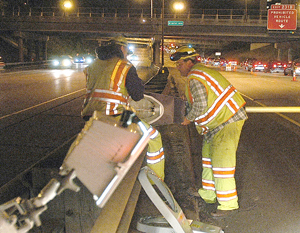
Crews replace light fixtures on I-94 in Minneapolis east of the Lowry Tunnel. Night crews wear reflective gear to be more visible to traffic during their night work tasks. Photo by David Gonzalez |
If you’re traveling down the highway some night, particularly in the Twin Cities area, you may notice brightly lit work zones and road crews in high-visibility clothing filling potholes, repairing guard rails, pouring concrete, you name it.
Doing some road construction and maintenance work at night is one way MnDOT is minimizing the impact to the traveling public and increasing motorist safety.
“Crews can sometimes work more efficiently at night when traffic volumes aren’t as high as during the day,” said Michael Beer, Metro construction engineer. “Night time also is helpful for contractors to more efficiently get materials and equipment to and from a project in reduced traffic congestion.”
The Interstate 35W at 94th Street and Hwy 100 projects in the Twin Cities involve bridge redecking work, which requires new concrete. Pouring concrete during cooler night temperatures prevents it from drying faster than it should and makes for a more durable, longer lasting deck, said Beer.
In Owatonna, another project requires night work so crews can place bridge beams on the newly constructed abutments of I-35. In this project, roads will be closed from 9 p.m. through 5 a.m.
Maintenance projects are also sometimes done at night. MnDOT employs several maintenance crews specifically to work night hours.
“Many corridors and routes are so heavily traveled that night time is the only time we can do the work safely,” said Greg Coughlin, Metro director of operations and maintenance. “If we’re filling in potholes or repairing guard rails, we might have lane closures that we can’t get by with other than nights or on weekends. At night, we’re also not impacting communities and people’s daily business.”
Crews often get projects done faster at night because of fewer traffic interruptions.
“Our lane closure policy limits windows of time on many corridors to do maintenance work. The 10-hour shifts are efficient since most night crews load up and go from site to site,” said Coughlin.
When a significant duration of night construction work is necessary, MnDOT sends a letter to people who live or work near the construction zone. The letter explains the construction activity, the expected noise levels, the duration of the work, and provides contact information. The letter is mailed, emailed or hand delivered to all residences and businesses within 500 feet of the work zone. Often, a news release or email alert is also issued.
Construction activities generally prohibited between 10 p.m. and 7 a.m. include pile driving, concrete pavement removal, pavement sawing, concrete crushing and jack hammering. There are times, however, when noise-producing operations occur at night due to the need for pavement to be cured or sawed.
Coughlin said a risk of night work is the potential for drivers who are tired, distracted or under the influence.
“With less traffic on the road, drivers’ speeds can be greater,” Coughlin said. “Motorists should be cautious in work zones at night, slow down and be alert for crews working.” |
 |
|

|
 |
TABLE of CONTENTS
 |
Seeds, Phoenix student worker programs grow tomorrow's leaders |
By Sandy Caron, Human Relations Recruitment Programs
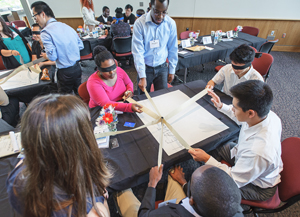
Participants in the Seeds/Phoenix Day Aug. 7 took part in a team building activity. Photo by David Gonzalez |
The annual Seeds/Phoenix Day was held Aug. 7 with the theme of Growing Tomorrow’s Leaders Today. The event included awards and recognition, comments by Commissioner Charlie Zelle, keynote speaker Eric Davis, panel discussions, a team building activity and leadership workshop. The Seeds Student Worker Program celebrated its 21st anniversary and the Phoenix Internship Program celebrated its ninth year.
The Seeds program is a four-year student worker program for college minority or economically disadvantaged students, recently separated veteran students and students with disabilities. Seeds is not an acronym, but a concept of MnDOT to “grow our own” talent while diversifying its workforce. MnDOT currently has 25 Seeds students in the program. Placement rate for students completing the Seeds program is 82 percent.
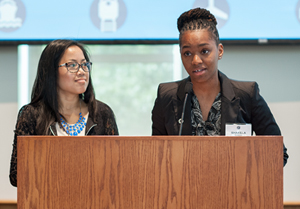
(from left) Manysavahn Phothisane, Seeds student at the Bridge Office; and Shakela Murrell, Seeds student in Land Management; hosted the Seeds/Phoenix Day event Aug. 7. Phothisane and Murrell also gave a presentation on what good leadership means to them. Photo by David Gonzalez |
The Phoenix program provides paid internships for high school seniors who are enrolled in science, technology, engineering and mathematics pre-engineering courses at area Project Lead the Way schools. The goal is to connect with students prior to college, promote MnDOT as an employer of choice, and encourage a career in engineering and transportation. There are five Phoenix students in the Bemidji District office, Willmar District office, Metro and Central Office. Many Phoenix interns transition from Phoenix to the Seeds program.
Both student worker programs are held in high regard by other state agencies and units of government because of the high rate of success.
Human Resources manages the Seeds and Phoenix programs. For more information, contact Calahena Merrick or Lorianna Yang. |
 |
|

|
 |
TABLE of CONTENTS
 |
Agency's records retention schedule gets major overhaul |
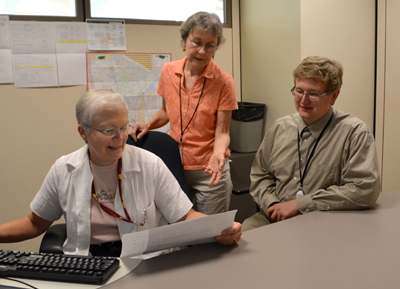
(from left) Nancy Melvin, administrative policy manager; Pam Newsome, records manager; and Charles Stech, assistant records manager; discuss the new MnDOT records retention schedule. The updates involved input from every district and specialty office. Photo by Rich Kemp |
It took about a year and a half, with consultant assistance and the participation of many employees across MnDOT. The result is a new agency-wide Records Retention Schedule.
The retention schedule has not been updated in its entirety since 1989. The old schedule had more than 1,700 items on it and was based on organizational units rather than on functions and activities.
The new schedule uses a “bigger bucket” approach to consolidate to 450 records. They are organized by MnDOT’s existing data domains and subject areas that were originally part of the Data Business Plan. The concept expanded into a classification system for all of MnDOT’s data and records. Since the organization chart changes frequently, organizing data and records by “what we do” is more stable over time.
The transformation of the retention schedule involved input from every district and specialty office. Participants included data domain stewards, subject area stewards, office and district records contacts, and many other groups of employees. They identified current, obsolete and redundant entries on the old retention schedule. They also reviewed retention times and the new consolidations, and assigned records to domains and subject areas.
The team consisted of Pam Newsome, records manager; Charles Stech, assistant records manager; and Imerge Consulting.
“The level of interest and participation from employees throughout MnDOT was a key factor in completing this project,” said Newsome. “They were instrumental in coming up with a product that was unanimously approved by the State Records Disposition Panel, which consists of the State Archivist, Legislative Auditor, and Attorney General.”
The MnDOT Governance Council approved the new schedule on April 15; the State Records Disposition Panel approved it on May 20.
In addition, the Governance Council approved the updated Records Retention and Disposal Policy July 15, reinforcing the importance of MnDOT’s records and data as valuable assets.
“The policy is a companion governance document to the Records Retention Schedule, which describes the legal obligations that must be followed, and the responsibilities within MnDOT for records retention and disposal,” said Nancy Melvin, administrative policy manager.
All policies are available on iHUB, MnDOT Policies and Program.
In the near future, the schedule will also be in the Business Data Catalog on iHUB. From there, it will be possible to search the retention schedule by keyword terms, and to generate reports of records by domain, subject area, or other criteria. Questions about records retention should be directed to pam.newsome@state.mn.us or charles.stech@state.mn.us.
In the coming months, the Records Management team will meet with districts and offices to familiarize staff with the new schedule and to start gathering information about where their records are stored (both paper and electronic). Improvements in records management practices and policy administration are WIG-supporting activities led by the Office of Chief Counsel.
|
 |
|

|
 |
TABLE of CONTENTS
 |
Pavement Preservation Partnership to hold regional meeting |
|
The Midwestern Pavement Preservation Partnership will hold a regional meeting in Minneapolis at the Renaissance Depot Hotel Sept. 2-5. MPPP is an AASHTO regional forum of pavement professionals from state and provincial agencies, contractors, suppliers, academia, local and federal officials, all working together to take advantage of the synergy gained from sharing information and identifying common issues for further investigation. It provides a forum to share and publicize information describing improvements in research, design, specifications, materials, and construction practices, and to promote the benefits of Pavement Preservation through education and application. For more information check out the website or email ncpp@egr.msu.edu. |
|
 |
|

|
 |
TABLE of CONTENTS
 |
MnDOT encourages fairgoers to Get Connected at State Fair booth |
By Mary McFarland Brooks

The State Fair booth includes a “Get Connected” theme and a “Rest Stop” where visitors can take a break and watch short videos of transportation projects and innovations. Photo by Kevin Gutknecht |
The annual Minnesota Get Together is here again and MnDOT’s exhibit theme of “Get Connected” encourages fairgoers to communicate about transportation topics that are important to them.
Volunteers at the exhibit will provide information about road projects and show how transportation connects Minnesota residents with their community, region and world.
“The fair gives MnDOT the opportunity to hear from Minnesotans from all over the state about their transportation experiences,” said Commissioner Charlie Zelle. “Stop by and chat with us. We want to hear about what’s important to you and your family.”
The booth has doubled in size, but remains located in the Education Building at 1372 Cosgrove Street. This year's display highlights how transportation improvements along busy corridors help the economy by keeping traffic and freight moving; how use of innovative technology on projects shortens traffic impact and improves safety; and how the projected growth of traffic and freight during the next 15 years will affect the state’s aging infrastructure.
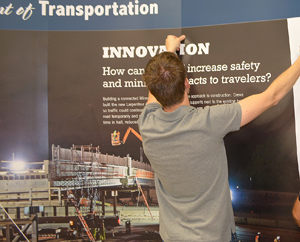
Adam Peterson, Communications, who designed the backdrop for the State Fair booth, helps set up the display Aug. 19. Photo by Mary McFarland Brooks |
Visitors to the exhibit can watch short videos at the MnDOT “rest stop,” depicting a range of transportation projects and innovations, including a snow storm from the driver’s seat of a snowplow to seeing the Larpenteur Avenue Bridge slide into place. Fairgoers can also complete a short survey that will make them eligible to win a MnDOT T-shirt or Minnesota transportation history book in a daily drawing.
Check out Metro District crews as they drive a snowplow in the State Fair’s daily 2 p.m. parade on Friday, Aug. 22; Wednesday, Aug. 27; and Friday, Aug. 29.
Also, visit the Kick Gas exhibit at the Eco Experience Building on Randall Avenue, east of Cooper Street where MnDOT staff will be handing out state bicycle and transit maps and encouraging people to bike or walk to some of their destinations.
More information can be found at the MnDOT State Fair website.
|
 |
|

|
 |
TABLE of CONTENTS
 |
On the Job: Brad Peters helps ensure MnDOT emergency readiness |
By Becky Dahlberg
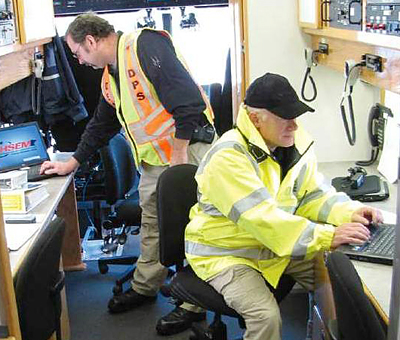
(from left) Brad Peters, emergency management coordinator; and Rick Luth, Homeland Security and Emergency Management; participate in a public safety exercise. Photo courtesy of the Radio Resource Media Group |
Brad Peters has his work cut out for him keeping MnDOT and Minnesota safe and ready for any kind of emergency.
Peters is an emergency management coordinator, along with Doug Stahl, for the department’s Central Office. They work with statewide emergency contacts to safeguard Minnesota’s critical transportation infrastructure from acts of terrorism, natural disaster and other emergencies. Peters and Stahl work under the direction of Todd Haglin, emergency management and safety manager.
How did you first get involved with emergency management at MnDOT?
I got involved with emergency management at MnDOT when I joined the department in 2012 as the emergency management coordinator. I became a certified state emergency manager back in 2009, and before I joined MnDOT, I worked for the Department of Public Safety as an emergency manager in their operations section, doing radio communications.
What does MnDOT emergency management entail?
MnDOT’s Emergency Management section conducts risk assessment, planning and training to safeguard Minnesota’s critical transportation infrastructure from acts of terrorism, natural disaster and other emergencies. We represent MnDOT at meetings with other state agencies to help develop overall plans, policies and procedures for statewide emergency management, and send liaisons to the State Emergency Operations Center in St. Paul whenever it’s activated during critical incidents such as flooding.
What does a typical day look like for you?
As emergency management coordinator, I’m responsible for the continuity of MnDOT’s day-to-day operations. Basically this means that I do the best I can do to ensure MnDOT can still operate even if we lose communications or suffer some kind of catastrophic event. I help maintain and update emergency plans and develop new ones that guide MnDOT through disaster response and recovery, and I coordinate safety drills with other state agencies. I’m also the point of contact for duty officers, building issues, security-related issues, and more, and do risk and vulnerability assessment training on our facilities statewide to assess gaps in security.
What are some of the challenges of your job?
My primary goal is to make sure that our people are aware of and protected from threats big and small, which can be a challenge when dealing with both overarching plans and policies on a statewide level and with employee safety and security on a more individual level. Another challenge with an agency this large is that there are a lot of things being done redundantly, and I’ll see some areas with a lack of communication and others with duplicate communication. Ideally, I’d like to see us incorporating a common operating system for the whole agency.
What are some of the positives of your job?
One current positive is the increased awareness about emergency management procedures. Another good thing is that our new mass notification system for emergencies, Send Word Now, is deployed and working! We’re using the system to notify employees about power outages and other situations with the ability to send messages through various means including cell phone, email, home phone, etc. The notification can be sent to particular groups of employees and scaled based on the type of emergency (i.e. in emergency plowing situations).
Have there been any recent emergencies you’ve had to deal with?
The state Emergency Operatios Center was under partial activation due to the recent flooding and MnDOT provided various assets and partnered with other agencies to combat the flooding. The EOC was completely activated back in June when the flooding first started, and as a transportation agency we were requested to help with sand bagging, road closures and more. Now we’re in more of a recovery phase. Nobody wants to think about winter weather, but there was also a nasty ice storm last April at the tail end of the season which damaged some Allied Radio Matrix for Emergency Response towers, and we were tasked with debris removal and getting the radio system operational again.
What is one thing that all MnDOT employees should know about emergency management?
If there is an emergency, employees will be notified as soon as possible. We are closely tracking situations and keeping an eye on things in order to keep everyone safe and day-to-day operations running smoothly.
For more information about emergency management plans and contacts, visit http://ihub/security/.
Do you or a co-worker have an interesting job to share with readers? Click here to send us your ideas, and we’ll contact you for more information.
Recent employee profiles:
|
 |
|

|
 |
TABLE of CONTENTS
 |
What’s new on the web |
Design-build website
MnDOT’s design-build website was recently updated and reorganized to enhance its functionality, meet department accessibility standards, and for optimum viewing on mobile devices like smart phones and tablets.
The website has current, future and completed design-build project information, as well as resources for contractors bidding on the projects. There are eight design-build projects currently under construction, including three in greater Minnesota and five within the Twin Cities Metro area.
For those unfamiliar with the program, design-build is a delivery method that awards contracts to teams of contractors and designers prior to the completion of final plans. In most cases contracts are let around 30 percentplan completion, although some design-build projects, such as the Crookston Slope or the I-35W St. Anthony Falls Bridge, have been let during or shortly after the scoping phase. In either case the design-build teams bring the preliminary designs to completion and construct the project under a single design-build contract.
MnDOT first began using design-build in 1996. Since 2001, MnDOT has awarded more than $1 billion in design-build projects.
For general program information or to schedule informal design-build training/education for your unit, contact Peter Davich at 651-366-4233 or peter.a.davich@state.mn.us.
For more information about design-build projects, visit www.mndot.gov/designbuild
Congressional Transportation Status Report
The MnDOT congressional website was recently updated to reflect current 2014 projects and information about MnDOT District Operations.
The website provides statewide transportation project information for Minnesota’s Congressional Delegation. Projects can be referenced both by MnDOT district and by Congressional district.
MnDOT Government Affairs, Federal Relations unit works closely with the Minnesota members of congress on transportation policy issues and on communicating updates on important transportation projects throughout the state. In addition, they provide updates on all projects located in the congressional districts within MnDOT districts through the congressional transportation status report website.
For more information, visit: www.mndot.gov/congressional/.
Updated travel request form
The out of state travel request form has been updated. This form is in lieu of the special expense form. It is found under forms in the A-Z section of iHub.
New Library Materials
New Library Materials are available at www.mndot.gov/library/newlibmat.html. This issue highlights the Electronic Library for Minnesota (ELM) that provides Minnesota residents online access to magazine, journal, newspaper and encyclopedia articles; eBooks (online books); and other information resources.
New Library Materials is a compilation of new titles and other resources added to the library collection during the previous month. If you would like to be added to the distribution list, contact pamela.m.gonzalez@state.mn.us or 651-366-3749.
Previous editions of New Library Materials are archived and available at www.dot.state.mn.us/library/recacq-archive.html. For other information requests, contact the Library at 651-366-3791 or e-mail library.dot@state.mn.us, or send requests via the “Ask a Librarian” web page at www.dot.state.mn.us/library/asklibrarian.html. |
 |
|

|
 |
TABLE of CONTENTS
 |
District 1 Border Subarea goes, literally, into the wild for its WIG |
By Chris Cheney, District 1 Border Subarea supervisor
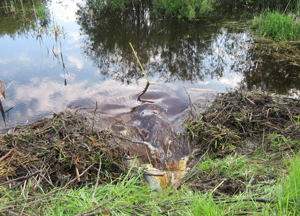
A beaver dam plugged a 140-foot-long culvert on Hwy 53 in northern St. Louis County. Photo by Chris Cheney |
You might wonder how a rodent would become the focus of a “Wildly Important Goal,” but oddly enough, the Castor Canadensis—the North American beaver—has become just that for District 1’s Border Subarea.
Our subarea lies within the Rainy River drainage basin, a water-rich environment with bountiful wetlands, streams and rivers — ideal beaver habitat — and there are many beavers! The border area produces a good share of the 20,000 to 30,000 beaver pelts harvested in Minnesota each year; I recently identified 40 beaver dams in a one-mile radius near Togo using Google Earth.
Since the end of our snow and ice season, I have hired contract trappers to remove the beavers at 42 sites. At an average price tag of $450 per site it gets very costly, plus it’s impossible to trap all of the beavers.
After the beavers are removed, the dam is blown up with binary explosives. The remaining beavers move to new sites and set up camp by plugging a convenient culvert and creating an instant beaver pond!
Almost every day during the summer at least one of our four Border Subarea truck stations has work scheduled to remove a beaver dam from a ditch or drainage structure. This work is done with backhoes, excavators, explosives, and a great deal of hard physical work.
Fifty or more dams are opened up by the subarea’s blasting crew each year.
All of this adds up to a lot of money, spent on a problem that never seems to completely go away.
One plugged, 140-foot-long centerline culvert on Hwy 53 in northern St. Louis County kept a full crew and excavator busy for six days removing beaver dam debris from inside the culvert. We could have replaced that culvert three times with that amount of labor expense.
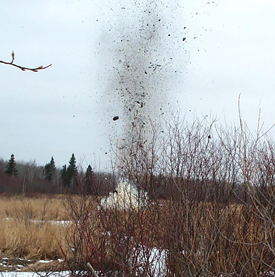
A subarea’s blasting crew from District 1 opens up a beaver dam with explosives. The dams have created flooding issues by plugging culverts. Photo by Chris Cheney |
I truly love beavers, admire their amazing abilities and recognize them as one of God’s great creations. And I identify with their busy nature — my wife tells me that if I were an animal, I would likely be a beaver. My practical side reminds me that they are rodents and a wonderful natural resource that needs to be managed for the well-being of our environment and the safety of our roadways.
So the problem is obvious — bountiful beavers living in various bodies of water adjacent to our highways. Each drainage structure beneath a highway provides a convenient opportunity for beavers to easily create a dam and flood the highway. Off-take ditches can also be quickly dammed, raising the water level for miles along highways, causing saturation of the road base, water on the road, fallen trees, flooded driveway entrances and flooded ditches.
Our Wildly Important Goal is focused on reducing beaver-created drainage problems and beaver management costs.
Tactics:
- Contract trappers to control problem animals.
- Use pond leveling devices wherever possible.
- Remove dams as soon as the beavers are trapped to ensure that other beavers don’t think — “Wow, this is my lucky day!” and move into the recently vacated site.
- Track all drainage-related costs on iPads.
- Blast dams in winter after ice forms. We have learned that this is the most efficient way to keep beavers from rebuilding their dams. The beaver can’t rebuild in winter and we have observed that in some cases it is six or seven years before they rebuild in an area that was blasted in winter.
- Communicate with local property owners and county and township road authorities to co-ordinate efforts in problem areas.
- Keep constant vigilance over areas of known beaver activity to keep the roadways safe and drainage structures open.
I know that beavers will remain a major WIG for our subarea into the foreseeable future.
I see bountiful beaver populations as an indicator of a healthy environment and from here in the Border Subarea, on the north slope of the Laurentian Divide, home of Voyageurs National Park and the western end of the Boundary Waters Canoe Area Wilderness — that is a very good thing.
Editor’s note: We’re interested in hearing how other MnDOT work areas are tackling their Wildly Important Goals. Send your stories to newsline.dot@state.mn.us or call Rich Kemp, 651-366-4279.
About Castor Canadensis…
By Chris Cheney, District 1 Border Subarea supervisor
The beaver, the largest North American rodent, is an active woodcutter and dam builder. When beaver populations get too high, they cause problems by cutting down valuable trees and flooding roads with their dams. Beavers' ability to change the landscape is second only to humans.
With their strong jaws and teeth, beavers can chew through a six-inch tree in 15 minutes. A single beaver can chew down hundreds of trees each year. Beaver-felled trees keep maintenance crews very busy clearing the highways in District 1.
- Length: May attain a length of 60 inches; 35 to 40 inches is typical.
- Weight: Weighs as much as 90 pounds; 40 to 50 pounds is average.
- Color: Various shades of brown
- Average life span: 12 years
- Food: In spring and summer, beavers eat leaves, buds, twigs, fruit, ferns, stems and the roots of water plants. In fall and winter, they eat cuttings from trees stored beneath the water.
- Predators: Coyote, wolf, bobcat, cougar and bear.
- Habitat and range: Beavers occur in every Minnesota county. Many biologists believe that the beaver pond supports a greater variety and abundance of wildlife than any other ecosystem in the forest. The ponds also control spring runoff, thus lessening the possibility of downstream flooding. But as one biologist said, “A beaver in the wrong place is a nuisance. In the right place, he is an ideal conservationist.”
- Population and management: During winter, a beaver colony will include the two adults, their spring babies and often year-old beavers. In June, after the new litters are birthed, the two-year-old beavers leave their home lodge and seek new territory. Minnesota has a regulated beaver trapping season, but there are not enough trappers to keep beaver populations small enough to prevent problems.
|
|
 |
|
______________________________________________________________________________ -->
| |
|



